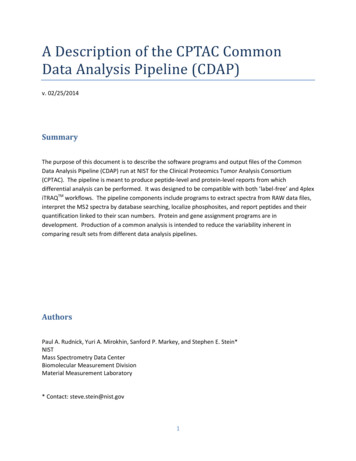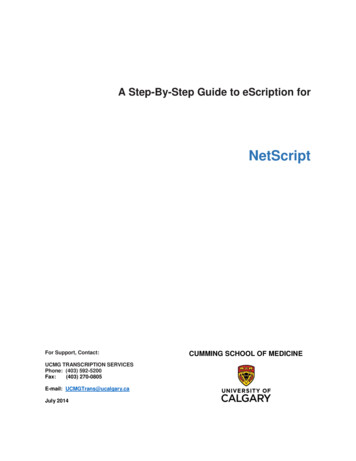
Transcription
A Description of the CPTAC CommonData Analysis Pipeline (CDAP)v. 02/25/2014SummaryThe purpose of this document is to describe the software programs and output files of the CommonData Analysis Pipeline (CDAP) run at NIST for the Clinical Proteomics Tumor Analysis Consortium(CPTAC). The pipeline is meant to produce peptide-level and protein-level reports from whichdifferential analysis can be performed. It was designed to be compatible with both ’label-free’ and 4plexiTRAQTM workflows. The pipeline components include programs to extract spectra from RAW data files,interpret the MS2 spectra by database searching, localize phosphosites, and report peptides and theirquantification linked to their scan numbers. Protein and gene assignment programs are indevelopment. Production of a common analysis is intended to reduce the variability inherent incomparing result sets from different data analysis pipelines.AuthorsPaul A. Rudnick, Yuri A. Mirokhin, Sanford P. Markey, and Stephen E. Stein*NISTMass Spectrometry Data CenterBiomolecular Measurement DivisionMaterial Measurement Laboratory* Contact: steve.stein@nist.gov1
Table of ContentsSummary . 1Authors. 1Conventions used in this document . 3Major output files . 3Step 1 – Data file QC . 4Step 2 – Spectrum Extractions . 4Command-line Options for ReAdW4Mascot2.exe . 4Step 3 – Identification of Peptide MS/MS Spectra by Database Search. 5Command-line Options for MS-GF . 5Reference FASTA Files . 6MS-GF Results Files . 6Step4 – MS1 Data Analysis Using ProMS . 6Step 5 – Calculation of QC Metrics . 7Step 6 – Phosphosite Localization by PhosphoRS . 7Report Files . 8Structure of Peptide Spectrum Match Files (.psm). 82
Conventions used in this documentThis font is used to highlight a software program, command-lineoptions, or to display the contents of a file.Bold is used to highlight a program name, file type or data file format.Major output files.psm – Peptide spectrum match reports in tab-delimited text.mzid – MzIdentML files produced from the .psm files at the DCC3
Step 1 – Data file QCFiles are retrieved from the CPTAC Data Coordinating Center (DCC) and checksums verified.Step 2 – Spectrum ov/download/peptide library/software/current releases/ReAdw4Mascot2/) was used to convert Thermo ScientificTM mass spectrometry files to MGF andmzXML formats for MS/MS searching and MS1 data analysis, respectively. It makes use of XCalibur’ssoftware libraries if they are installed, otherwise it will attempt to use MSFileReader from ThermoScientificTM .asp?id 703).Command-line Options for ReAdW4Mascot2.exeFor LTQ data, the following command-line is used:“-sep1 -NoPeaks1 -MaxPI -metadata -PIvsRT -c -sepZC -xcal -xpw 10 -xpm32 -XmlOrbiMs1Profile –c file .RAW out directory ”For Orbitrap and QExactive data files, the following options are added:“-ChargeMgfOrbi -MonoisoMgfOrbi –FixPepmass”For iTRAQ4plex, add:“-iTRAQ “For iTRAQ8plex, add:“-iTRAQ8 “Both MGF and mzXML files are for internal use only but are available by request.ReAdW4Mascot2.exe also extracts iTRAQ4plex or iTRAQ8plex reporter ion values and reports themin the TITLE line of the MGF files. A value for variability of each iTRAQ channel is also given in these fieldas the dMZ/HWHM where dMZ (m/z) / ExpectedResolution(at m/z). A value 1 typically indicatesisolation window contamination. These values can be used to impose penalties on identified spectrawith abundant impurities. AbFract is also calculated; this is the fraction of the MS2 TIC accounted for bythe reporter ions. All iTRAQ values are copied in the PSM reports.4
Step 3 – Identification of Peptide MS/MS Spectra by Database SearchMSGF geId 13533355) is used to identify peptidesfrom protein sequences. This program was formerly named MS-GFDB and was developed at theUniversity of California San Diego (http://www.ncbi.nlm.nih.gov/pubmed/20829449) (Kim S. et al, MolCell Proteomics, 2010, 12: 2840-52). Its development continues at PNNL by Sangtae Kim.Command-line Options for MS-GF For Orbi/HCD and QExactive data, the options are the following:“java –Xmx3500M –jar MSGFPlus.jar -d file .fasta -t 20ppm -e 1 -m 3 inst 1 -ntt 1 -thread 2 -tda 1 -ti 0,1 -n 1 -maxLength 50 -mod file .txt"For phospho, add:“-protocol 1”For iTRAQ, add:“-protocol 2”For iTRAQ and phospho, add:“-protocol 3”For Orbi/CID, change:“-m 3” to “-m 1”For Q-Exactive , change:“-inst 1” to “-inst 3”The contents of the mods.txt files are the following:“NumMods N-term,Pyro gluH-3N-1,Q,opt,N-term,Pyro-glu”5
For phospho, add:“HO3P,STY,opt,any,Phospho”For iTRAQ4plex, replace:“H-2O-1,E,opt,N-term,Pyro 63,*,fix,N-term,iTRAQ4plex”And add:144.102063,K,fix,any,iTRAQ4plex”Reference FASTA FilesThe protein FASTA file used for CompRef analysis is concatenated RefSeq H. sapiens (build 37), M.musculus (build 37), and the sequence for S. scrofa (porcine) trypsinogen. The FASTA file used foranalysis of the TCGA human samples lacks the M. musculus sequences.MS-GF Results FilesMS-GF results are produced in (mzIdentML) mzid format and are converted to tab-delimited text (TSV)using the following command-line options:“java -Xmx3500M -cp MSGFPlus.jar edu.ucsd.msjava.ui.MzIDToTsv -i file .mzid -o file .tsv -showDecoy 1”These .mzid and .tsv files are for internal use only. A new .mzid file is produced from the final .psm (seebelow) files at the DCC.Step4 – MS1 Data Analysis Using ProMSProMS is a peak processing program developed at NIST used to calculate precursor peak areas fromextracted ion chromatogram, peak widths, and other features of the MS1 data. ProMS reads mzXML6
files, the previous standard for peak lists developed at the Institute for Systems Biology (ISB), which hasbeen replaced by mzML.ProMS expects to find a proms.ini file in the directory containing the mzXML files to be processed. Aproms.ini file should contain the following:“ mzXML file .raw.mzXML search result file .raw.FT.hcd.ch.MGF.mzid.tsv output file .raw.txt search engine name: MSGF , MSPepSearch, SpectraST, OMSSA) instrument: ORBI HCD, ORBI, LTQ, QTOF ”The program is run on each mzXML file separately to produce txt file reports. These reports areessential for calculating peptide ion abundances and for many QC calculations performed bynistms metrics.exe.Step 5 – Calculation of QC MetricsFor the purposes of the CDAP, no QC metrics are included in the reports. However, performancemetrics, as described in Rudnick et al MCP 2010 Feb;9(2):225-41, are used internally for the purposes ofquality control.Step 6 – Phosphosite Localization by PhosphoRSPhosphoRS (http://www.ncbi.nlm.nih.gov/pubmed/22073976) (Taus T., et al, J Proteome Res, 201112:5354-62) is used to score MSGF assignments for site localization. These scores are embedded intothe peptide sequence in the ‘PhosphoRS’ field of the .psm files. PhosphoRS scores 0.99 are used toconfidently assign a localization. If all phsophosites for a PSM are confidently assigned, ‘FullyLocalized’in the .psm files is set to’Y.’Psm2Xml.exe – produces an input file for ProsphoRS reading scan numbers and sequences from the.psm file and corresponding spectrum from the mgf file.Psm2Xml input psm file . input mgf file output xml file PhosphoRS command-line:java –jar phosphoRS.jar input xml produced by Psm2Xml output xml Add phospho psm.exe – reads site probabilities from PhosphoRS output xml file and produces anupdated psm file.7
Add phospho psm input original psm file input xml produced byPhosphoRS output updated psm file These programs are available by request.Report FilesThis section describes the contents of the reports uploaded to the CPTAC Data Coordinating Center(DCC).Structure of Peptide Spectrum Match Files (.psm)The .psm files are given in tab-delimited text with Windows-style line-returns. The data are pre-filteredto a q-value level (FDR) of 0.01. Warning: q-values in files with 500 identifications may not beaccurate.The fields in purple below are copied directly from the search MSGF result files.The fields in orange are for iTRAQ reports only.The fields in green are for phosphopeptide reports only.FileNameRaw file nameScanNumThermo MS2 scan numberQueryPrecursorMzPrecursor m/z used at search time (PEPMASS value in MGF file). This may be different than thatin the RAW file.OriginalPrecursorMzPrecursor m/z recorded in the RAW file for this MS/MS spectrum.PrecursorError(ppm)This is calculated as the difference between the theoretical and measured m/z in parts permillion.QueryChargePrecursor charge as listed in the peak list file.OriginalChargePrecursor charge as calculated by XCalibur. This may be different than QueryCharge ifReadW4Mascot.exe disagrees (rare).PrecursorScanNumScan number of the previous MS1 scan. A “?”in this field denotes inferred precursor scannumber.PrecursorArea8
This is the precursor area in ion counts as calculated by ProMS from the extracted ionchromatogram of the precursor. These values can be used for relative quantitation.PrecursorRelAbThis value is calculated by ProMS as the fraction of the total ion count (TIC) accounted for bythis precursor ion. This may also be useful for label-free quantitation.RTAtPrecursorHalfElutionThis is the retention time at which half of the precursor ion has eluted according to ProMS.PeptideSequencePeptide sequence annotated with modifications (by mass shift) from MSGF AmbiguousMatchThis field is marked ‘Y’ if multiple top-ranked hits are present. In these cases, multiple matchesare listed for a single MS2 scan.ProteinAccession number(s) for all protein matches attributable to the corresponding peptide sequencegiven in the PeptideSequence fieldDeNovoScoreSee MSGF documentation and publicationsMSGFScoreSee MSGF documentation and publicationsEvalueSee MSGF documentation and publicationsQvalueSee MSGF documentation and publications. This value is used to filter the results in the .psmfiles to hits with QValues 0.01 (or 1% FDR) per file.PepQvalueSee MSGF documentation and publications.PrecursorPurityThis field reports the precursor purity values for the isolation window in the previous and nextMS1 scans. These values are useful for monitoring contamination in iTRAQ experiments.FractionDecomposition1 – the fraction of remaining precursor intensity in the MS2 spectrum. Useful for assessing howwell the precursor was fragmented at this collision energy level (HCD only).HCDEnergyThe collision energy applied to fragment the precursor to derive this scan. This is not thenormalized values set by the instrument operator by the actual energy applied at fragmentationtime.iTRAQ114Actual abundance of the 114 channel followed by a quality score dMZ/HWHM dMZ / (MZ / Re)where dMZ is the deviation, MZ is the theoretical MZ for the reporter ion and Re is the expectedresolution at 400 (reported for the scan). Values above 0.5 usually indicate a major problem with peakfinding.iTRAQ115Actual abundance of the 115 channel followed by a quality score dMZ/HWHM dMZ / (MZ / Re)where dMZ is the deviation, MZ is the theoretical MZ for the reporter ion and Re is the expectedresolution at 400 (reported for the scan). Values above 0.5 usually indicate a major problem with peakfinding.iTRAQ116Actual abundance of the 116 channel followed by a quality score dMZ/HWHM dMZ / (MZ / Re)where dMZ is the deviation, MZ is the theoretical MZ for the reporter ion and Re is the expected9
resolution at 400 (reported for the scan). Values above 0.5 usually indicate a major problem with peakfinding.iTRAQ117Actual abundance of the 117 channel followed by a quality score dMZ/HWHM dMZ / (MZ / Re)where dMZ is the deviation, MZ is the theoretical MZ for the reporter ion and Re is the expectedresolution at 400 (reported for the scan). Values above 0.5 usually indicate a major problem with peakfinding.iTRAQFlags‘I’ if the geometric mean of the two ‘PrecursorPurity’ values is 90%. (It is known that thisthreshold is too strict. Empirical data suggest that only PrecursorPurity values 80% may be subject to“compression”‘M’ if one or more iTRAQ channels has a zero value‘D’ if the quality score for one or more of the iTRAQ channels is 1iTRAQTotalAbSum of the ion current for the iTRAQ peaksiTRAQFractionOfTotalAbiTRAQTotalAb divided by the TIC for the MS2 spectrumPhosphoRSPeptidePeptide sequence annotated with PhosphoRS probability scores. Scores for any site 99.0should be considered localized. It is possible to only localize one of several sites. This peptideannotation will frequently be different than that given in PeptideSequence by MSGF .nPhosphoThe number of phophosites expected by the precursor m/zFullyLocalized‘Y’ if all phosphosites score 99.0, otherwise ‘N’10
A escription of the PTA ommon ata Analysis Pipeline ( AP) v. 02/25/2014 Summary The purpose of this document is to describe the software programs and output files of the Common Data Analysis Pipeline (CDAP) run at NIST for t











